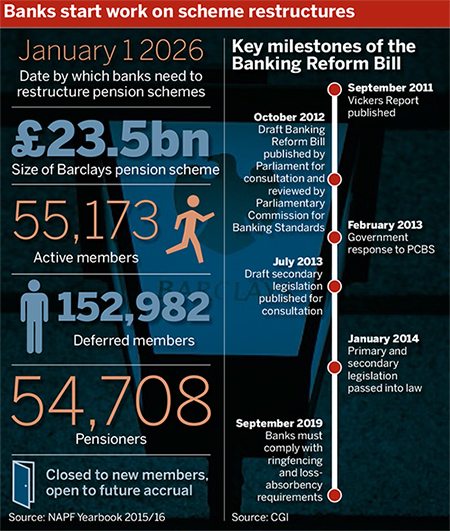Barclays is assessing which of its entities will participate in the bank’s UK Retirement Fund from 2026, when ringfencing regulations become fully effective, as schemes across the sector face up to complex covenant questions.
The 2013 UK Banking Reform Act required UK institutions to separate or ‘ringfence’ retail and small to medium enterprise depository businesses from the rest of their operations, a regulatory shift that will have wide implications for pension schemes attached to these entities.
To comply with the broader regulatory requirements, pension schemes must be restructured so that a ringfenced bank cannot be responsible for the pension liabilities of other members beyond the ‘fence’ across the wider group.
The government has provided banks and trustees with flexibility in tackling the demands of restructuring, recognising this could involve splitting up an existing scheme, establishing a new scheme or segregating a scheme into multiple sections.
Restructuring can happen in one of two ways – either the scheme is split into two by a transfer out into another scheme of one part, or it is segregated into two, separately funded sections. The latter will need significant changes to the rules of the scheme
Rosalind Connor, ARC Pensions Law
Radical revisions of scheme structures throw up multiple legal and practical questions for all parties involved, particularly around the strength of newly ringfenced covenants (likely to weaken as each scheme is backed by fewer employers), the extent to which sponsors will fund implementation and the role contingent asset arrangements and parent company guarantees could play in schemes’ longer-term future.
A big issue
In this context, Rosalind Connor, partner at law firm ARC Pensions Law, said the requirements are a “big issue” for banks and their pension schemes, with many turning to the Pensions Regulator for guidance to be “on the safe side” amid a highly complex terrain.
She said restructuring can happen one of two ways: either the scheme is split into two by a transfer of one part into another scheme, or it is segregated into two separately funded sections.
“The latter will need significant changes to the rules of the scheme,” she said.
The restructuring process must be completed by January 1 2026, five years after the ringfencing rules will first apply to the bank, Connor said.
“It obviously feels like a long time, but it is a long process and most banks appear to be looking at the issue already,” she said.
Proactive engagement
A spokesperson from the regulator said the schemes involved are some of the biggest in the country and it is therefore appropriate for the regulator to “proactively engage” with trustees.
“The legislation says a bank required to ringfence only needs to apply for clearance if there is material detriment to the scheme.
“However, we would expect the trustees to have completed significant due diligence and form their own view of whether the proposed restructure is materially detrimental to the scheme,” the spokesperson said.
The regulator, the Prudential Regulation Authority and HM Treasury have already held large working group meetings with all the banks and trustees involved, which will continue on a more individual level as discussions become scheme and bank-specific, the spokesperson added.
Alex Hutton-Mills, managing director at covenant specialist Lincoln Pensions, said a central concern for trustees should be to understand which entities are “on the hook” for liabilities, which, as “creatures of acquisitions”, may be a tough question to answer for banking structures.
“As part of the process leading up to ringfencing, trustees will want to understand the ‘pre’ and ‘post’ position and the potential impact [of that shift] on their integrated risk management,” he said.
“Once ringfenced, contingency planning is going to need to be put in place to facilitate further restructuring,” which, he added, could involve parent company guarantees and contingent asset arrangements.
Hutton-Mills said establishing a clear picture of where the scheme ranks as an unsecured creditor of the sponsor is key.














